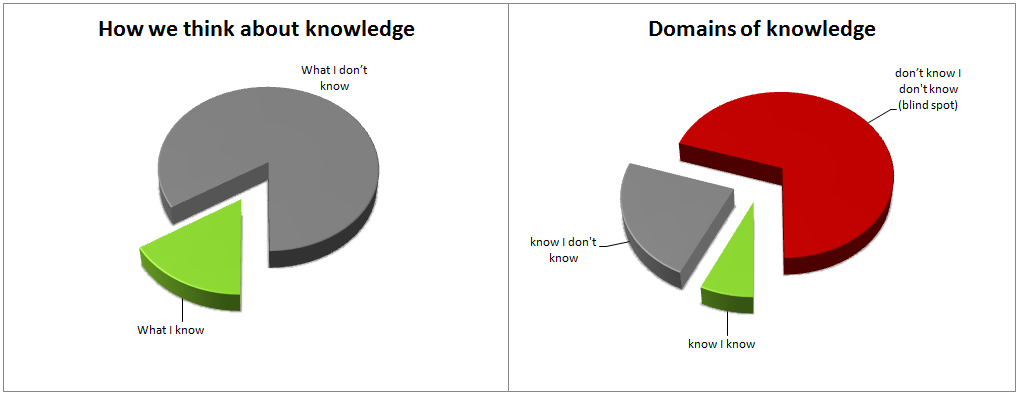 In this article, I’m going to show you how you can take learning Spanish to a whole new level by explaining learning blind spots: how they can cripple your progress and how to find and eliminate them.
In this article, I’m going to show you how you can take learning Spanish to a whole new level by explaining learning blind spots: how they can cripple your progress and how to find and eliminate them.
Donald Rumsfeld famously said, “There are known knowns; there are things we know we know. We also know there are known unknowns; that is to say we know there are some things we do not know. But there are also unknown unknowns – there are things we do not know we don’t know.”
In 2002, his statement received criticism as tortuous use of the English language, but in fact Rumsfeld was paraphrasing from decades old insights into knowledge and learning. We tend to live our lives as if there are only two domains of knowledge: what we know and what we don’t know, and we go about assuming we know what we don’t know: I know I don’t know how to fly a plane, for example. The insight that Rumsfeld was alluding to, however, is we have knowledge blind spots and our blind spots come from another area: that which we don’t know that we don’t know.

Things in this domain are usually called unknown-unknowns.
In language learning, learning Spanish for example, this domain is vital to your progress because in fact, includes things that we think we know but don’t.
Confused? Phew! Me too! Let’s use a few examples to make this simple. Let’s assume that you’re a beginner (if you’re not, you can extend these examples to your own level easily, or indeed any other topic that you might be learning beyond the Spanish language).
Something you know (known-known)
- the word for ‘doctor‘ in Spanish is un médico.
(If you didn’t know this, you do now)
Something you don’t know (known-unknown):
- the word for ‘nurse’ (if you know this, you pick a word that you don’t)
Because you know that you don’t know it, you can look it up and find out. (It’s una enfermera, if you were wondering).
There is no loss of learning power here. All good.
Now let’s say that you also know how to say “he is“: (él) es.
So you know how to say “He is a doctor“: Es un médico, right?
Wrong. The correct answer is Es médico.
This sort of thing crops up in language learning all the time. It’s a very common transference error, a type of language learning blind spot that arises from assumptions we make about language. We assume things work the same way in Spanish as in English and because people won’t normally correct you when you make mistakes like this – they understand you and they don’t want to interrupt or be rude – you start to actively practise mistakes believing them to be correct, see (don’t practise your mistakes).
This is one classic example of something you don’t know that you don’t know.
There are other things you don’t yet know that you’re not aware you should know, way beyond your current level, but this is more insidious than that. This is something you think you know – but you’re wrong! You keep doing it, and every time you do, you reinforce bad habits in your speech.
It’s the linguistic equivalent of walking around smiling, oblivious to the spinach stuck to your teeth.
Your blind spots can cripple your progress and your confidence, because while you may not know the specifics, you still have a vague sense that you’re making mistakes but you never know what they are.
Strategies for handling Spanish language blindspots
Here are some ways you can power up your learning:
1. Don’t leave testing to the end of the learning process. Take Spanish tests regularly and often, and focus on fixing the things you thought you knew. (Our Spanish tests are specially designed to help you distinguish your blind spots from other areas that you don’t know.)
2. Ask people to correct you – don’t rely on people doing it without permission. By and large they won’t.
3. In Spanish especially, there are clusters of blindspot areas which require extra practise: for example, Spanish syntax around use of pronouns is quite often the opposite to English. Just being aware of this can help you to ask if you’re saying things correctly.
Your confidence in Spanish will go up dramatically when you are confident in basic grammar, and the only way to get confident is to practise the right stuff. You can only fix mistakes that you know you’re making, so take the time to find out what they are and eliminate them.
Our intelligent testing technology can help you do exactly this. Ready to see your blindspots? Take a Spanish test now.